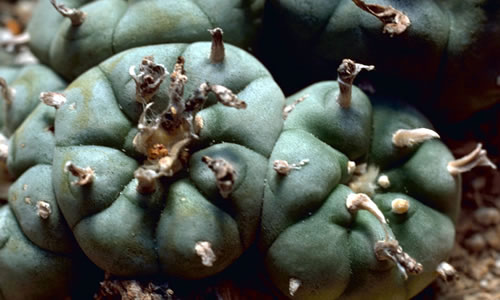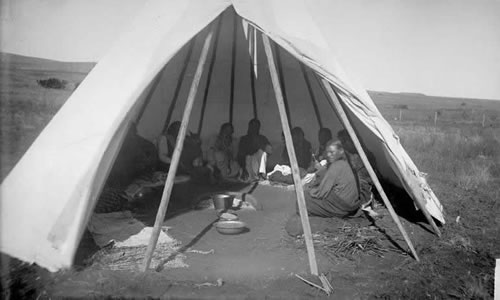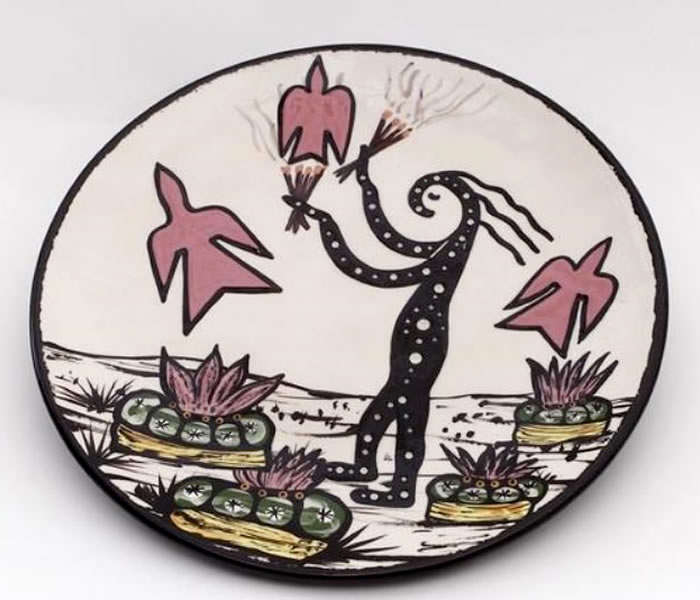Hallucinogens

Hallucinogens are compounds that cause distinct changes in perception, emotional state of mind, and awareness of space and time, medically defined as sensory delusions. Psychoactive plants with compounds in this group include the peyote cactus, Datura species, Salvia divinorum, and various morning-glory species such as Turbina corymbosa. Psychoactive fungi with potent hallucinogenic compounds include the famous red and white-capped mushroom, Amanita muscaria, and the cereal grain fungus ergot (Claviceps spp.).
Peyote Cactus (Lophophora williamsii)
The ritual use of peyote in Mexico and North America goes deep into the past. Numerous peyote-decorated figurines and artifacts dating back to pre-Columbian times have been found in Mesoamerican tombs and archeological sites. Historically, peyote was used as a medicinal plant to treat high fevers, headaches and other ailments. The psychoactive ingredient of the peyote cactus is the alkaloid, mescaline, a powerful vision-inducing intoxicant.
The religious and ceremonial use of peyote is still practiced among the Huichol, Tarahumara, and Yaqui peoples of North-central Mexico. For the Huichol, the peyote cactus represents the origin of the universe (Wirikuta) and keeps the memory of creation alive for the people. The ceremonial use of peyote in North America is believed to have been first introduced by the Mescalero Apache in the 1700s and is now widespread among many tribes. Members of the Native American Church can legally use peyote for sacramental purposes. Otherwise, the species is protected under the Convention on International Trade in Endangered Species (CITES).
Ololiuqui (Turbina corymbosa)
A member of the morning-glory family, the vine-like ololiuqui is another New World ritual plant whose use predates the arrival of Hispanic cultures. It was valued for its medicinal and psychoactive properties by the indigenous peoples of West Indies islands, Cuba and Central America, and North America’s gulf coast. It was not until the 1960s that scientists discovered the ololiuqui’s active alkaloids were closely related to LSD.
The shamans used it to induce powerful visions without the psychedelic effects. The early Spanish missionaries and diarists of the 1600s describe its use, “…when drunk, it deprives one of judgment. And the faith these unhappy natives have in this seed is amazing, since by drinking it, they consult it like an oracle for everything, whatever they want to know, even those things beyond human knowledge…” This species is extremely difficult to identify judging by its taxonomic history and confusion among closely related vines and morning glories, most of which lack the psychoactive alkaloids.
Ebena (Virola theiodora)
Not all hallucinogens are utilized orally or topically. Ebena is a potent hallucinogenic snuff used by the Yanomami and other native tribes in the Amazon Basin. Hallucinogenic snuffs have been used for centuries in the Amazon in religious and shamanistic ceremonies. The snuff is made from the bark of several Virola species (members of the nutmeg family) and the leaves of a local shrub, Justicia pectoralis. These and other added ingredients are made into a mixture that is heated and ground into a fine powder to make the snuff, which can then be stored for future use. Ebena’s role among Amazonian shamans is to contact earth, plant and animal spirits as part of healing and vision quest ceremonies.








